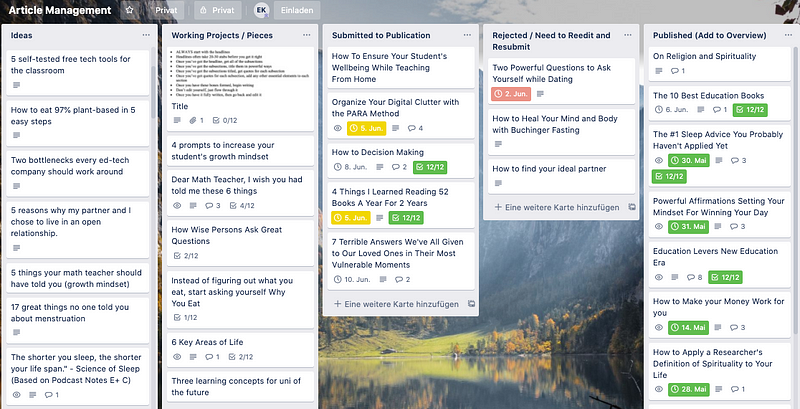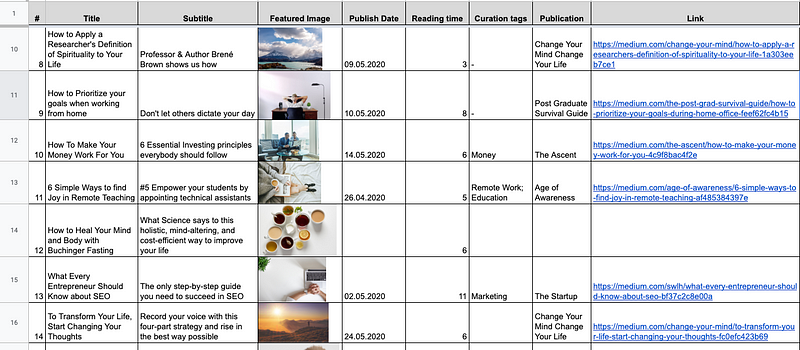90 hours of coaching broken down into 7 mins for you

Benjamin Franklin once said,
“An investment in knowledge always pays the best interest.”
This spring, I followed the advice and invested $699 in a medium coaching program. Until April, I hadn’t written anything except for 150 pages of academia and 1350 pages in my bullet journals. Since April, I’ve published 16 articles on medium and filed the resignation for my 9–5 job.
Here are 19 essential lessons I’ve learned about writing from my professional medium coach, and Benjamin Hardy, PhD’s online writing course:
1. If you’re a new writer, focus on white space
The less experienced you’re with writing, the more white space you’ll need. Section breaks, paragraphs, and subtitles help you deliver your message.
My first articles are living proof that white space works. I published this article before my first coaching session and this one after it. To this date, the first article earned 9$, the second 127$. These numbers show my medium coach was right about the importance of white space.
Reserve your longer paragraphs for the time you found your writing voice. Gary Provost, a famous American author, once demonstrated how to write longer passages that sound like music:
This sentence has five words. Here are five more words. Five-word sentences are fine. But several together become monotonous. Listen to what is happening. The writing is getting boring. The sound of it drones. It’s like a stuck record. The ear demands some variety. Now listen. I vary the sentence length, and I create music. Music. The writing sings. It has a pleasant rhythm, a lilt, a harmony. I use short sentences. And I use sentences of medium length. And sometimes, when I am certain the reader is rested, I will engage him with a sentence of considerable length, a sentence that burns with energy and builds with all the impetus of a crescendo, the roll of the drums, the crash of the cymbals–sounds that say, “Listen to this, it is important.”
2. Publish 100 articles before you expect anything
A writing career isn’t linear. In the beginning, while you’re learning the craft, don’t expect to earn anything. As with everything in life, there’s no such thing as an overnight success.
Making a living from writing is the result of hard work. Authors earning >2000$ on medium or other platforms have spent months practicing.
You can reach writing success as well if you’re willing to put in the work.
Most writers lose faith in their abilities before reaching exponential growth. Following my coach’s advice, I committed to publishing 100 articles before expecting any return on my time investment.
3. The only way to improve your writing is by writing
The only way to get better in writing is to sit down and write. Thinking about writing, speaking about writing, and reading about writing won’t be nearly as effective as writing.
Once my coach asked me the following question, and my writing practice changed:
Do you know there’s a difference between creation and consumption time?
While consuming is all about reading and learning, creating is the process of putting words on paper.
Here’s how I track writing vs. consuming time. Tracking helps me to find a balance between learning and writing.

4. Writing quality will improve with writing quantity
The quality of your words will increase with practice. Instead of editing yourself a fourth time, focus on producing more content.
As an economist, I’d label it as the diminishing return of editing: The longer you edit one article, the later you start a new one.
Ben Hardy explained it’s better to publish a lousy piece than not publish at all. Some of the articles he resisted to publish, went viral afterward.
Unless you stop editing a piece and spend your time on writing a new one, you don’t create. Don’t be too critical on yourself and identify perfectionism as another form of procrastination.
Publish before you think your piece is perfect. Writing quality will improve with quantity.
5. Build a daily writing/creating habit
To write a lot, you need a writing routine. While plenty of articles tout specific writing routines, you know best what works for you.
I get up at 6 AM, practice yoga, journal and meditate. At 6:40 AM, I start writing. By 9 AM, I’ve done all of my creative work and ride to work.
It doesn’t matter which routine you decide on, as long as you stick to the habit. Or, as Austin Kleon puts it:
“What your daily routine consists of is not that important. What’s important is that the routine exists. Cobble together your own routine, stick to it most days, break from it once in a while for fun, and modify it as necessary.”
Ask yourself,
When can you make time to write and focus without distraction?
What helps you getting into your creative state?
6. Always ask, “What’s in it for my readers?”
I felt incredibly proud to publish my first pieces. But my mentor made me realize my articles equaled personal journal entries. She asked:
Do you write for yourself, or do you write for your readers?
One should never write without your readers in mind. Here are some helpful questions, both from my mentor and the medium curation guidelines:
What’s in it for your readers?
Is your piece written for the reader?
Does this add value for the reader?
What do you want your readers to take away?
Which feelings do you aim to provoke?
7. Headlines make or break your stories success
Headlines are the entryway for your readers. If your headline doesn’t spark your readers’ interest, they won’t bother to read the first lines of your well-crafted introduction.
Benjamin Hardy jots down 10–20 headline versions for each of his pieces before he determines the best one. I follow this advice by spending 20 minutes on brainstorming headlines. Being strategic about headlines helps you reach more readers.
8. Check headlines, instead of your stats
My coach caught me on the spot with this one. Here’s what she said:
“The first times you get curated and published with bigger publications, it’s tempting to check your stats again and again. Especially if one article got published in a publication.
But instead of reviewing your cents trickling down, use your time wisely and study successful writer’s headline.”
Instead of checking your stats, study virality. Look at successful writer’s headlines, like Jessica Wildfire, Niklas Göke, Kris Gage, Liz Huber, and Tim Denning.
9. Combine logical with emotional writing
Before mentoring, I thought the number of high-quality sources lead to popularity. It turns out I’m wrong.
The combination of head and heart knowledge makes a story unique.
I come from academia, and it’s easy for me to combine other writer’s logic and craft a coherent story. However, when you look at best-performing articles on medium (like this one, this one, or this one), you’ll realize they don’t sound like peer-reviewed papers. Readers aren’t looking for pure facts.
Instead, it’s your personal experience, combined with a touch of logic, that speaks to your reader’s heart and triggers reactions. To start an article, my coach asked me the following helping questions:
What are the things you can’t stop thinking about?
What are you excited, angry, upset or inspired about?
Which difficult experience did you encounter and what helped you to overcome this?
10. Search images by emotions, instead of keywords
Choose a picture that supports the emotional message you’re trying to convey. Your answers to the questions above offer a great starting point for image search.
In the beginning, I used my pictures and searched at other platforms for the perfect image. But top medium stories demonstrate, in most cases, the built-in Unsplash image search is enough. While crafting your article, click on the + symbol and select the loupe. Then type in your emotion-triggering keyword.

11. Structure your article bones to write faster
Working for days on the same piece can leave you frustrated. Particularly, if you can’t see any progress. For writing development, Ben Hardy’s practice helped me the most. It might help you as well if you tend to get lost in your writing process. Here’s what he said:
“Always start with the headlines, then get all of the subsections.
Once you’ve got the subsections title them in powerful ways.
Once you’ve got the subsections titled, get quotes for each subsection or other essential elements you need.
Once you have these bones formed, begin writing.”
12. When you write, — write
Once you have the bones formed, focus on writing. When you stop for research or edit yourself, you break your flow state.
Focus on putting words on the paper. Don’t stop your flow. Don’t look for more knowledge. Use abbreviations for flowing through your craft.
- LINK if you want to link something later on write
- CHECK if you need to double-check what you’ve just written use
- IMG in case you want to add an image or graphic
Editing and researching interrupt your flow state. Add all of the above once you’re done with the first draft of your piece. When you write, just write.
13. When you don’t feel like writing, write
As said in the beginning, writing quality improves with quantity. Hence, you need to write consistently. When you don’t write, you don’t produce content. You don’t learn. You don’t improve.
Create environments that help you to write. In case you don’t know how to focus without distraction, no matter what, read Cal Newport’s Deep Work. If you only have a limited amount of time for writing, focus on smaller tasks like researching headlines, images, or coming up with new ideas.
On days, where you don’t feel like writing, try to compose the worst piece you can. It’ll make your process more fun.
14. Bury mediocre passages in your editing graveyard
Editing can hurt. Deleting entire phrases might feel like going backward. But to craft excellent writing, you should edit without compromise. Mediocre sentences will ultimately lead to average articles. Not every word you typed deserves to stay in your piece.
A document that serves as editing graveyard can help. This document has the sole purpose of editing more strictly and not clunch to useless words. You cut out all fluff from your original piece and bury it in your paper. In case you miss your words or want to reuse them for other articles, you know where to find them.
If you’re unsure whether to keep or destroy a passage, read the entire paragraph out loud. Your voice is a great editing tool after you’ve written your piece.
15. Use a system to manage your ideas and articles
The more you write, the more critical it is to keep an overview. Inspired by my medium coach, I use Trello for ideas and article management. Here’s how I use Trello:

In the column “ideas,” I store all headline and topic ideas. I prefill most idea cards with an outline and the described bones structure. Prefilled content helps to get into writing quickly. You no longer have to sit and wait in front of a blank piece of paper, waiting for ideas to cross your mind.
Once I started putting an idea onto paper, the Trello card moves to “working projects.” Some longer articles, like this one, linger around in “working projects” for a few days as I add ideas to the piece in several writing sessions.
When I finished editing the article and found both the headline and an emotion-provoking picture, I submit the article to a publication. In the “submitted to publication” column is a timestamp on every card that indicates when I expect to hear back from the publication.
In case publications rejected my article, I move the card to the “re-edit” column as my work needs further improvement. If a publication publishes my piece, I slide the card to “published.”
All articles in the “published” column receive an entry in my article overview sheet, which looks like this:

This excel sheet is a great motivator for reminding you of the work you’ve completed. Moreover, this system helps you keep track of the number of articles published, your curation tags, and the publications you’ve published with. You can use your sheet to set your writing KPIs.
What indicates your on track in your writing process?
Do you measure your success by the number of articles you published?
By the words, you’ve put on paper?
Is it the total reading time in minutes, that shows your effort?
Or is it the variety of publications you’re looking for?
Be clear about your key performance indicators. The clearer your goals, the easier it’ll be to reach them.
16. Publish with publications to reach more readers
Instead of self-publishing my first articles, I should’ve spent more time researching suitable publications. Here are the three benefits of publishing with publications:
- You reach more people
- By following publication guidelines, your writing improves
- Thereby, your chances of curation increase
Once you’ve written and edited your piece, research suitable publications, there are medium run publications like Onezero, Elemental, Gen, Zora, Forge and Human Parts, and prominent other publications like P.S. I love you, The Startup, The Ascent, or like this one The Writing Cooperative. If you’re unsure which publication might suit your writing, use medium’s search for your topic. Look which publications recently covered your area of expertise.
Don’t feel discouraged in case publications reject your piece. I applied three times for The Ascent before they accepted one of my articles. See the application process as a free learning opportunity; if editors reject your work, ask yourself how to improve your writing. Ask for feedback and use the publication guidelines to double-check.
17. Done is better than perfect
As a writer, you put your name behind everything you publish. I asked my coach several times how she determines a piece is “good enough.”
Instead of looking for the perfect breakthrough, give your best to produce as much useful content as you possibly can. You have to accept your okayish content if you want to become an exceptional writer.
Don’t overjudge your work and don’t fear to publish something that isn’t perfect. Once you’ve hit publish, you can let your fears go and focus on your next idea.
In retrospect, I wasted my time editing this article for 8 hours. I would’ve used my time better by posting earlier and creating more content.
Done is better than perfect. Hit “publish” once your piece is good enough.
18. Learn to write faster
Megan Holstein said in one of her inspiring articles on writing,
“Every writer’s business is a factory. We can choose to produce a better product, or we can choose to produce more of it. The more writing we put out to the world, the more readers might stumble across our writing.”
By publishing more than 30 pieces a month, my medium coach puts these words into action. Thereby, she earns more than most people I know. Moreover, with quantity comes quality. When you improve your writing speed, your writing quality improves likewise.
To increase my writing speed, I track the time I need to write an article. While this doesn’t sound highly creative, it helps me to keep my goal in mind and to focus on the process.
19. Ideas are everywhere
Whatever idea comes to your mind, be sure to capture it in your idea management board or a journal, so you don’t lose it. Ideas come best when you don’t aim to have them.
Here are some great prompts from my mentor, that helped me getting ideas:
Which stories can you tell from your life?
What’s interesting about your career?
Which resources have helped you in your daily life? How?
Which book have you read that triggered something in you?
What topic are you currently struggling with?
Which vulnerability do you dare to share?
Write about something you care about and be brutally honest about it.
Feel free to try anything you like, whether it’s investments one day and relationships the next. People follow you for your voice, rather than expertise on any given topic.
And whenever you lack ideas, check out Bookshlf to get inspired by academics, distinguished professionals, journalists, and online creators.